NORTH WALES COAST RAILWAY:NOTICE BOARD
Rheilffordd arfordir gogledd Cymru: Hysbysfwrdd
28 July 2020



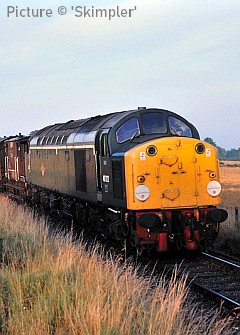
Forthcoming events
(see also our Calendar page for venues)
Note: we have removed all entries up to the end of August as the events are cancelled. The Railway Touring Company North Wales trains in July are no longer being advertised.
September 2020
Saturday 5 September Steam at Chester 'The Cheshireman' (Railway Touring Company). Norwich to Chester. Loco 6233 for part of the journey.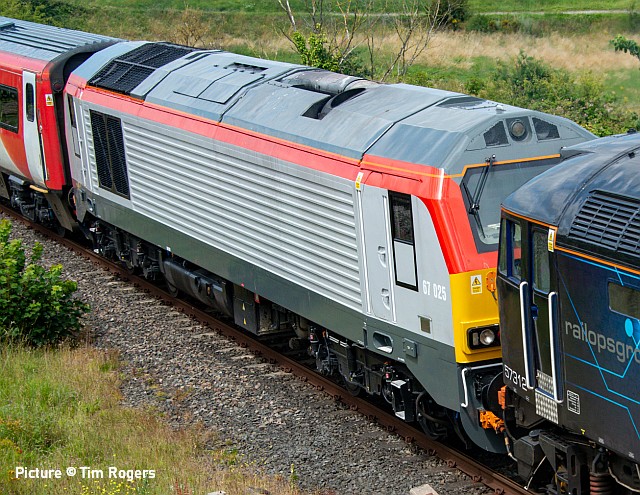
67 025 and 57 312 passing Bagillt. See story below (Picture by Tim Rogers.)
Class 230 doings
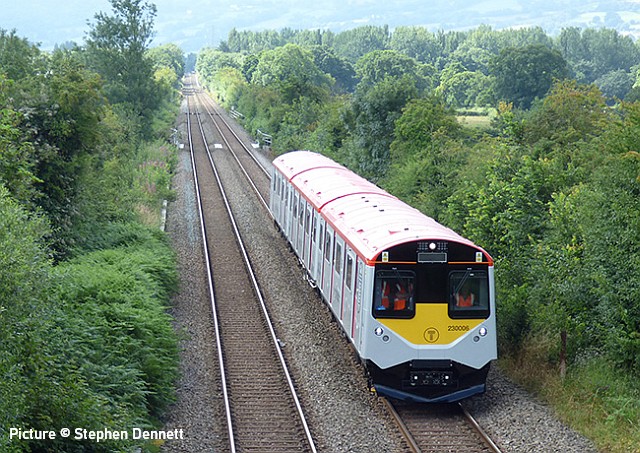
Trials with the new Vivarail unit continue, in the hands of Rail Operations Group drivers. On 24 July, taken from Bannel Lane bridge, just south of Buckley station, 230 006 approaches up the gradient from Penyffordd on its Wrexham to Dee Marsh run...
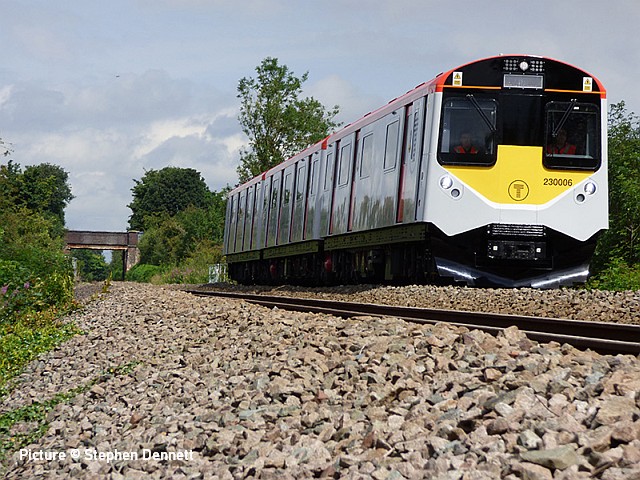
... and seen from the public footpath about 200 metres south of Bannel Lane bridge, it returns from Dee Marsh to Wrexham. Pictures by Stephen Dennett.
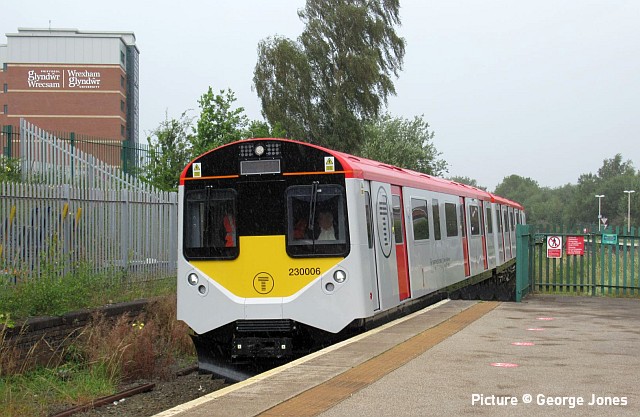
On 27 July another run to Wrexham Central was made: George Jones photographed 230 006 at Wrexham General's platform 4, which was once Wrexham Exchange station, heading for Central...
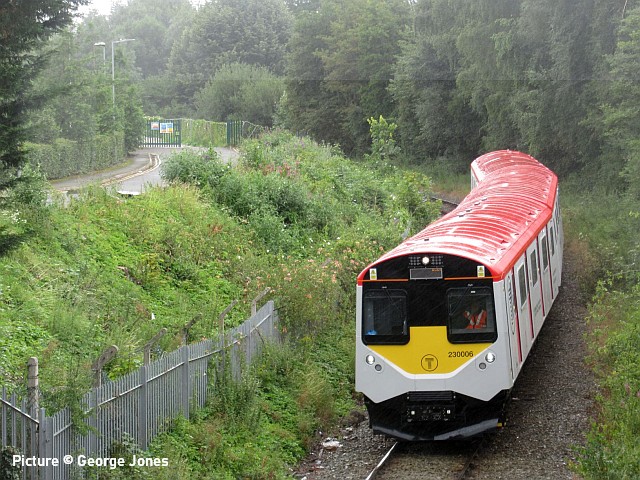
... and returning on the curve which passes below the main line.
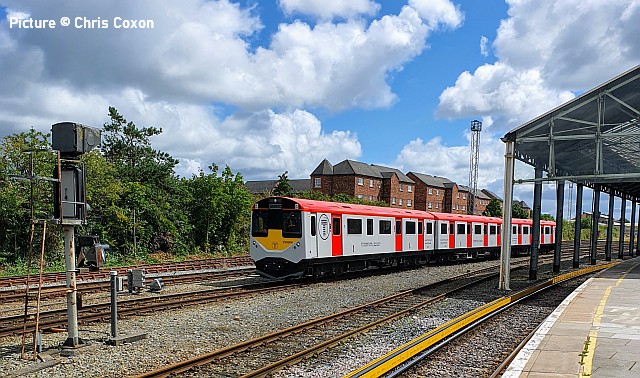
On 28 July the newcomer broke new ground by travelling to Chester and visiting the depot (Chris Coxon).
Llangollen prepares - report by George Jones
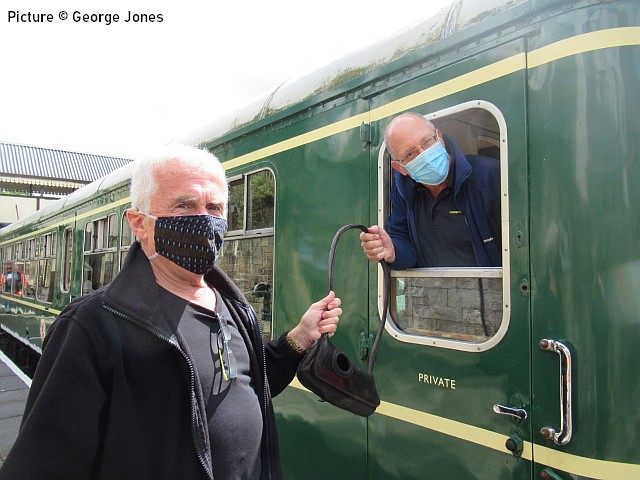
In less than promising weather this am, the Wickman heritage railcar unit ran to Carrog with operational volunteers on board to assess matters down the line. All part of a shake-down process which will take place this week when later trains might feature the class 31 diesel and 3802 in steam, as required by the procedures specified by the Office of Rail and Road for heritage railways, prior to reopening for passenger services from Saturday 1 August. Above: Suitably masked, the Llangollen signalman hands over the single line token to the class 109 Wickham driver prior to departure from a sunlit Llangollen station.
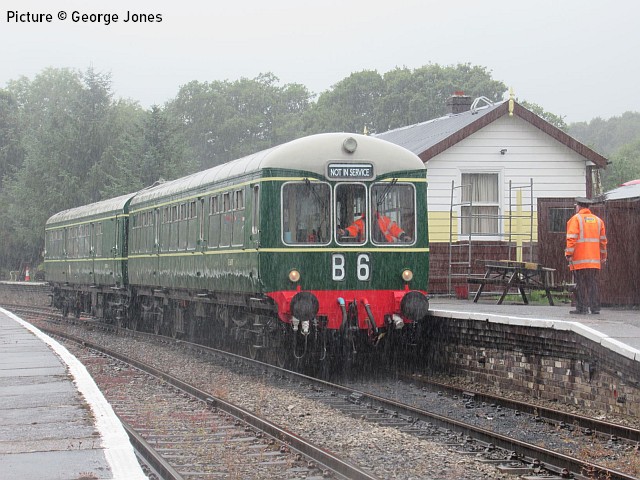
Earlier the Wickham was seen in the midst of a downpour at Glyndyfrdwy as it replicates the movement last seen on 17 March prior to suspension of services.
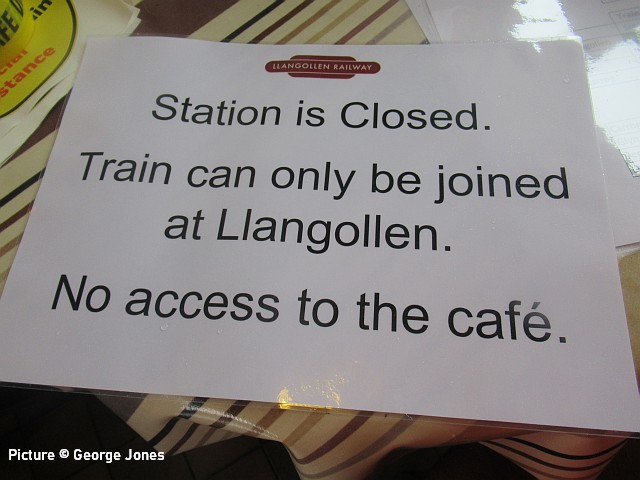
As of Saturday, initial arrangements call for all passengers to book in advance and join the train at Llangollen for the run to Carrog. Whilst the cafe will be open fort passengers at Carrog, subject to social distancing measures, the station will be closed for anyone wishing to join there.
Escape from Holyhead
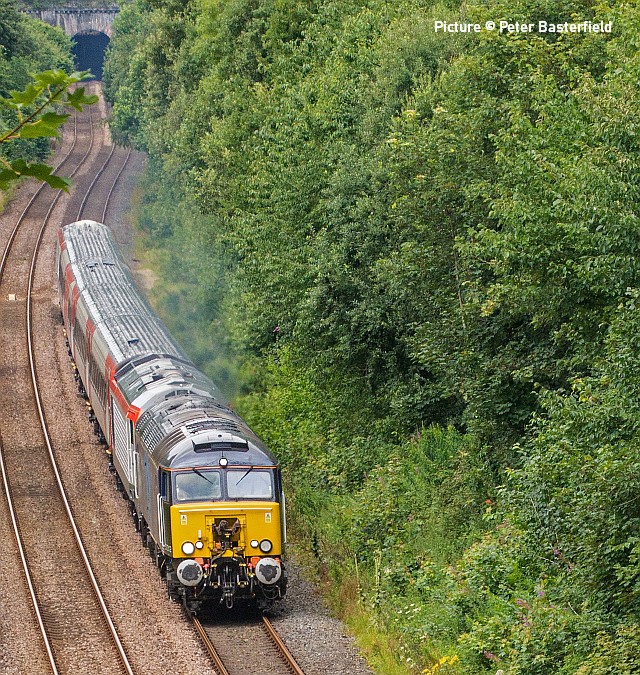
67 025 and its four ex-LNER coaches, one of the sets which will eventually work the Holyhead - Cardiff service, have been languishing in the sidings at Holyhead. On 24 July Rail Operations Group (who seem to be getting a lot of work from TfW) sent 57 312 to haul the train to Crewe. Picture above at Llandygai by Peter Basterfield.
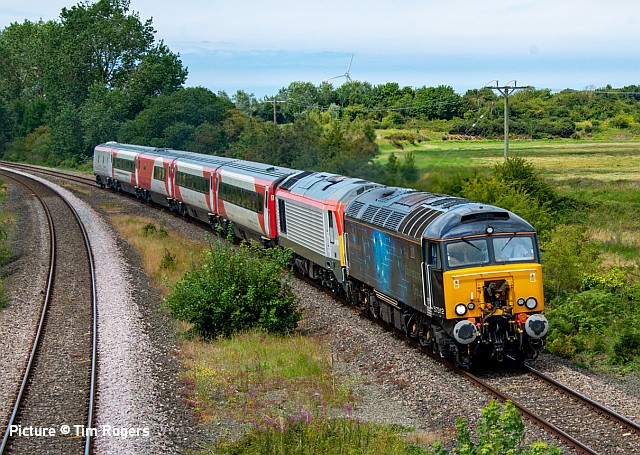
The working was 5N42 11:04 Holyhead Car. M.D. to Crewe C.S. which ran 58 mins late, rumoured to be due to 'a mix-up in Holyhead signalbox.'
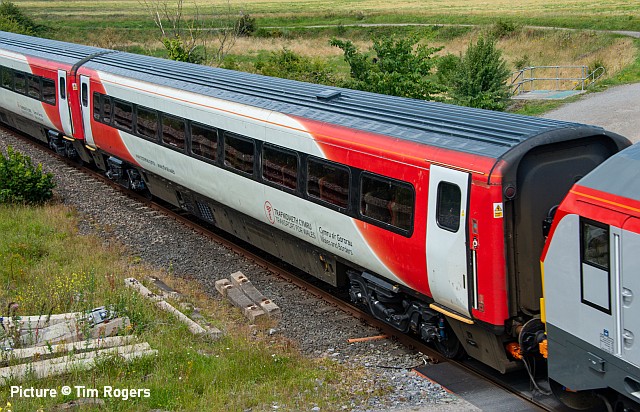
Mk4 Carriage 12219 behind the loco: as the end coach of the original LNER rakes, there's no gangway connection at this end. The formation was Standard class (end) 12219, Standard 12447, Catering vehicle 10238, first class 11324, Driving van trailer 82229. We still have no information about how TfW will overcome the fact that the First Class vehicle is not adjacent to the 'galley' as it was on the previous sets.
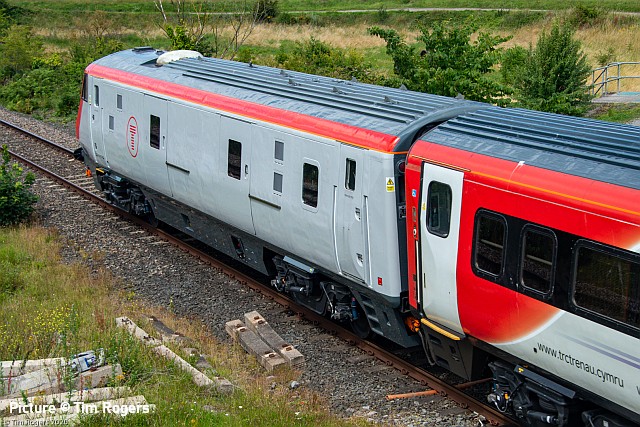
The Driving Van Trailer. The dome on the roof is an aerial for the passenger wi-fi. Pictures at Bagillt by Tim Rogers.
Porthmadog 24 July - pictures by Jim Ikin
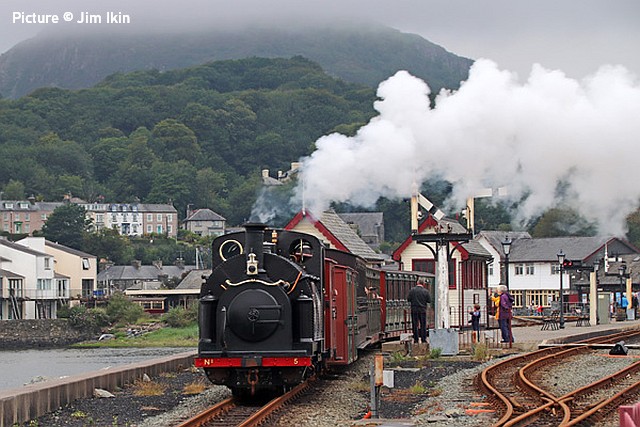
Following on from the images of Welsh Pony last week we visited Porthmadog on overcast Friday 24 July. Above, Welsh Pony departs with the pre-booked run to Tan y Bwlch.
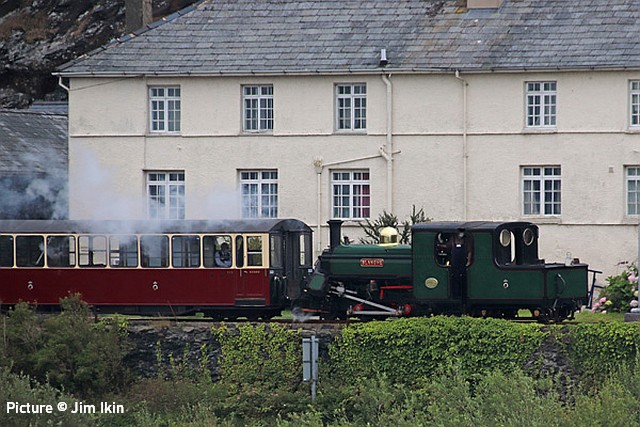
Blanche passes Boston Lodge returning to Porthmadog ...
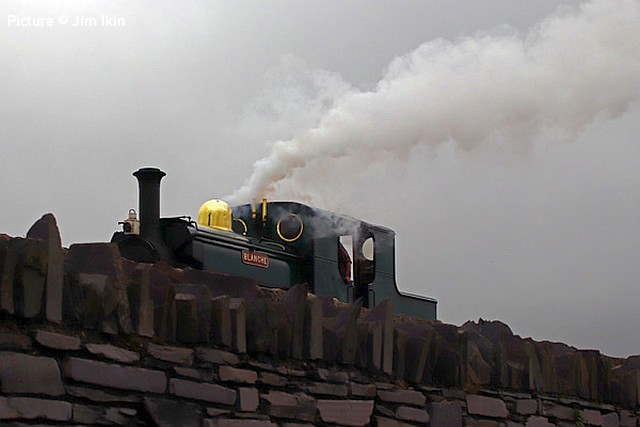
...returning to the lodge from the unusual angle from the lower footpath along the Cob.
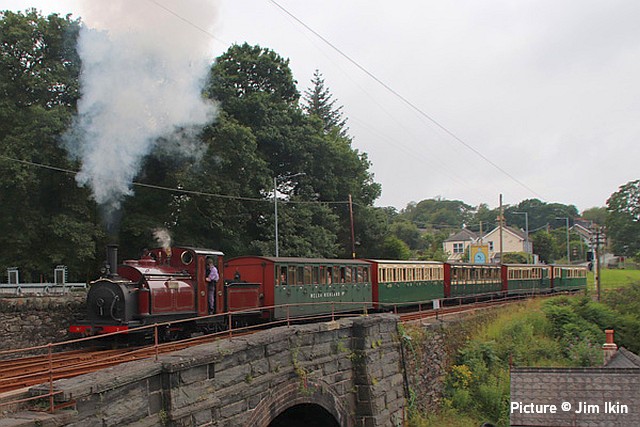
Prince enters Minffordd ...
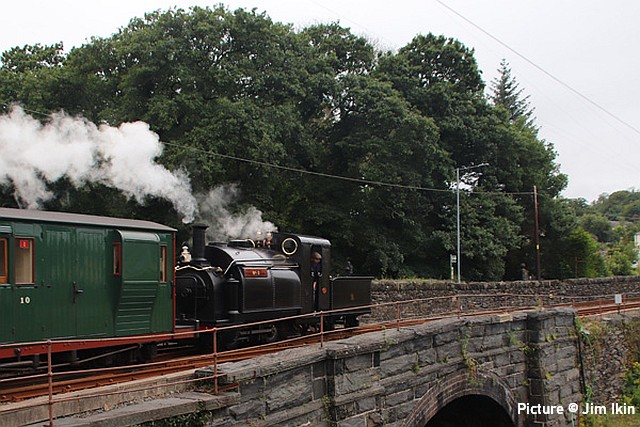
... and Welsh Pony which had been waiting then exits towards Porthmadog.
From the company website:
Our reopening service will only operate on the Ffestiniog Railway – from Porthmadog to Tan-y-Bwlch. Please note there will be no other train services on the F&WHR at present.
This new service will run daily, with six round-trips per day, and trains departing from Harbour Station at 10:00, 11:05, 12:10, 13:15, 14:20 and 15:25. The total journey time will be approximately 2 hours 45 minutes, including a one-hour layover at Tan-y-Bwlch. We encourage visitors to wear face coverings when travelling on our services and complimentary masks will be available on the platform.
All journeys start and finish at Porthmadog. Tickets must be booked in advance. Passengers cannot join (or alight from) trains at any other station, halt or request stop. Booking is for a whole compartment (22 per train), the price (£50) covers two people; another four can travel with you at £25 each (accompanied child £1).
Looking back with David Pool - Blaenau and Trawsfynydd
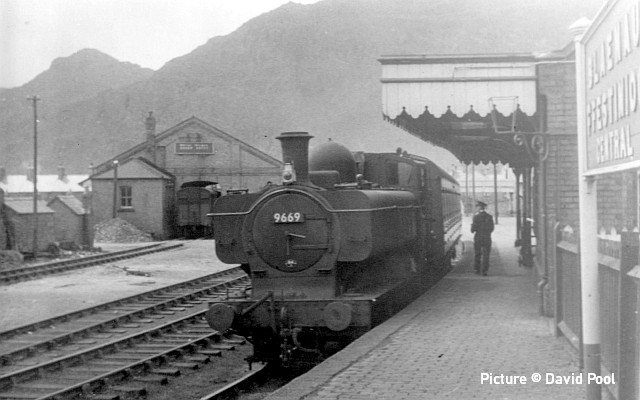
I managed to visit Blaenau Ffestiniog Central before the line to Bala closed in 1960. Western Region Class 57xx 9699 is waiting to leave with the 4.15pm train to Bala on 8 June 1957. The present Blaenau Ffestiniog station is now on this site. The negative has deteriorated with age, so a scanned print has been the best option, although there has been some loss of image quality.
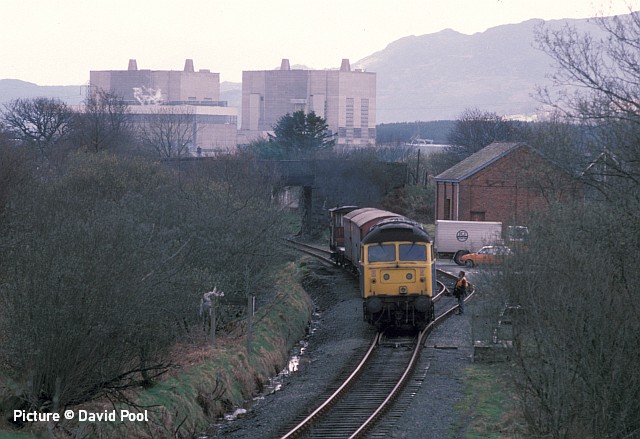
ICI’s Cookes Explosives at Penrhyndeudraeth were using Maentwrog Road as the railhead for their freight in 1988. On 30 March 47 323 has propelled from Blaenau Ffestiniog one VBA wagon with barrier wagons and a brake van, and has picked up another wagon alongside the Goods Warehouse. Note the ICI van which has accompanied the ICI lorry, and the Trawsfynydd reactor buildings in the distance..
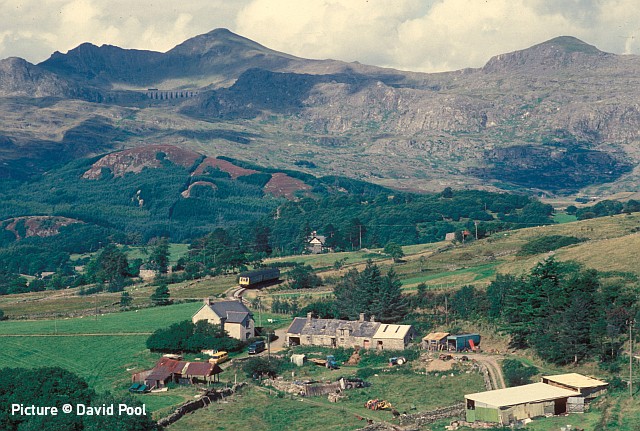
In 1989 and 1990 some extra revenue was generated by allowing the diesel unit working on the Conwy Valley line from Llandudno to travel beyond Blaenau Ffestiniog to Trawsfynydd. On 3 March 1989 a Class 108 (Chester set CH602) is near Teiliau-bach, with the Stwlan Dam and the Moelwyns dominating the scenery above Tan-y-Grisiau.
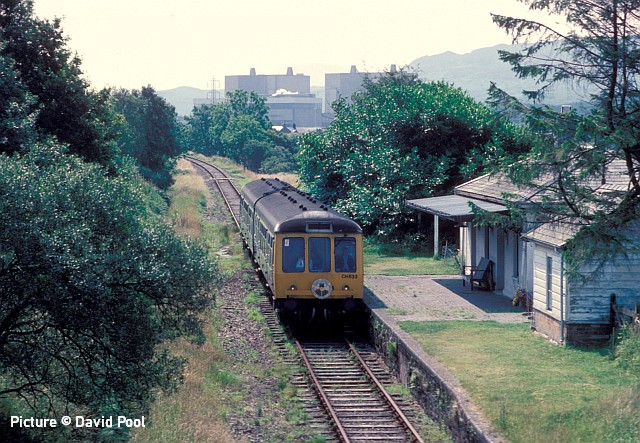
On 22 July 1990 the Trawsfynydd Shuttle from Blaenau Ffestiniog was being worked by Class 108 M53932/ M51569 (CH633), here passing the platform at Maentwrog Road, where the station building is a private residence. A temporary platform was constructed on the other side of the road bridge to serve the shuttle trains, but this train has clearly come from Trawsfynydd. I have a ticket dated 1990 which states “to Maentwrog Road”, and I suspect the journey extension to Trawsfynydd was on the basis of passengers remaining on the train. The planned use of another temporary platform at the former Trawsfynydd Lake Halt has been reported, but I cannot recall seeing any evidence that this was constructed or used.
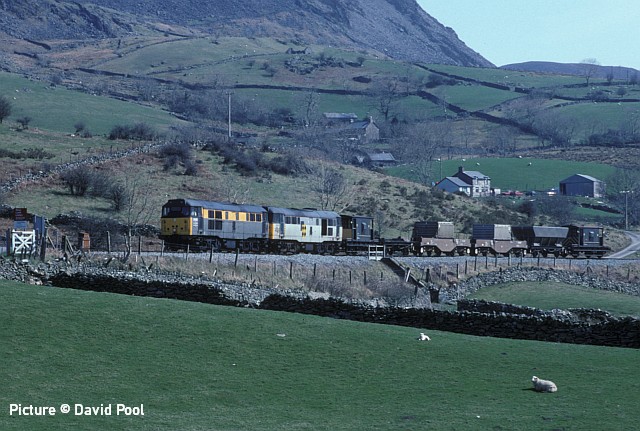
The 7D39 nuclear flask train from Trawsfynydd to Llandudno Junction on 13 April 1995 was being worked by 31 255 and 31 201, here approaching the site of Teigl Halt. To match the two locomotives, there are two brake vans, two flask wagons and two runner (barrier) wagons. At the Junction this would join 7D40 from Wylfa, which on this day was 37 108 plus two flasks. I later photographed the triple-header on its journey to Sellafield.
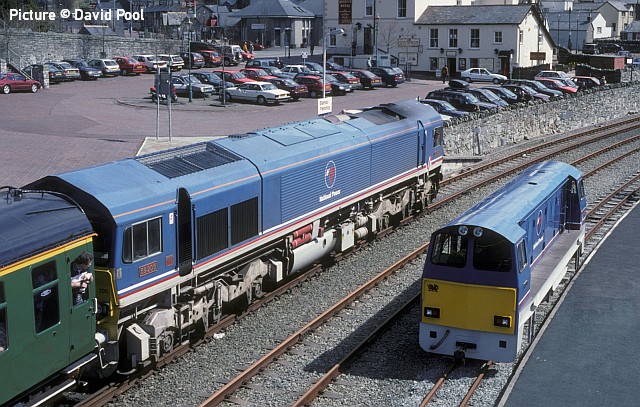
18 April 1998 was a day to be remembered at Blaenau Ffestiniog. A Hertfordshire Rail Tours “The Roman Nose” 1T54 from Euston to Trawsfynydd was headed by 59 205 in National Power livery after reversing at Llandudno Junction. At that time the Ffestiniog Railway had painted their Funkey diesel “Vale of Ffestiniog” in a similar livery, so of course the two had to meet.
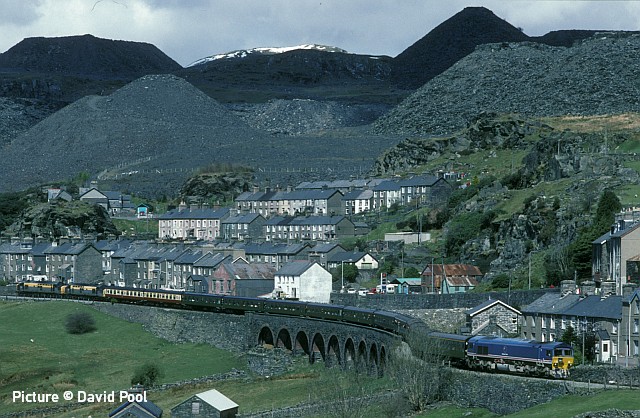
After the encounter with its narrow gauge cousin, 59 205 continued towards Trawsfynydd. The viaduct at Tan-y-Manod is the setting for the view of the thirteen Mk1 coaches and the two 37s, 37 377 and 37 098, on the rear of the train. The viaduct was originally wooden, but later rebuilt in stone. 59 205 is approaching the site of the GWR loco shed and sidings at Manod, long since removed.
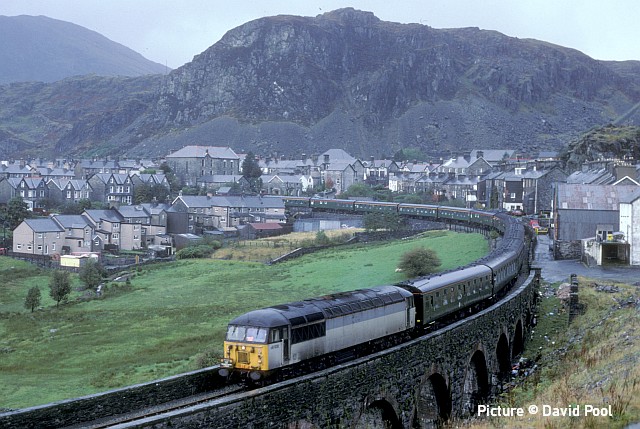
Taken from the main road, this view of Tan-y-Manod viaduct in typical Blaenau weather was taken on 17 October 1998. “The Trawsfynydd Lament” (1T70) was another from Hertfordshire Rail Tours, intended to be the last passenger train on the branch. It was running late, due to locomotive problems at Crewe, and I would guess that the condition of 56 108 might indicate that it was a last minute replacement. The loco on the other end was 47 785 Fiona Castle.
Dave Sallery's archive selection

Machynlleth on 12 September 1987: a picture full of interest, including the appearance of a traditional platform trolley; do any survive today?
37 426 (originally D6999) is hauling the 15:00 Aberystwyth - London Euston as far as Shrewsbury. One of the 'Wales and West' batch of 37/4 rebuilds, it was named Vale of Rheidol / Y Lein Fach by Tommy Jones, Chairman of Ceredigion District Council on 5 May 1986. The small plaque below the nameplate portrays a VoR locomotive. In 1991 it was transferred to the freight sector at Tinsley depot, and lost its name and blue livery, although it continued to work some passenger trains in the North West, Wales and finally Scotland as well as freights.
While working limestone trains from Peak Forest it gained the unofficial name 'Mt Vesuvius' inspired by the tendency of these locos to send flames out of the roof exhaust when starting under a heavy load. Eventually it was sold to DRS who appear to have used it for spare parts., before scrapping in 2013.
In the background is a Class 150/1 unit in the original Provincial Services livery; these trains with their 3 + 2 seating and narrow aisle were hardly suitable for the Cambrian Lines, especially when refreshment trolleys were deployed. The signalbox was built in 1960 to a design confined to the Western Region of British Railways, although shortly afterwards the line was transferred to the London Midland. It replaced two boxes, Machynlleth West and Machynlleth East. In 1988 it was adapted to control the 'RETB' signalling system, taking over the role of all the other boxes on the Cambrian lines. In was closed in 2011 when the new ERTMS signalling took over.
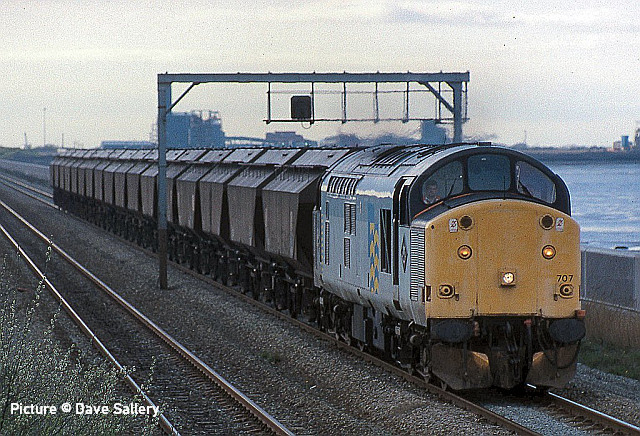
37 707 passes Ffynnongroew on 24 April 1994 with the return working of the Immingham - Anglesey Aluminium works flow of petroleum coke, a material used to make anodes for the electrolytic smelting process. This train ran, usually weekly, from 1971 until a fire at the Immingham refinery cut off the supply, and a new supplier delivered the material by sea at Holyhead.
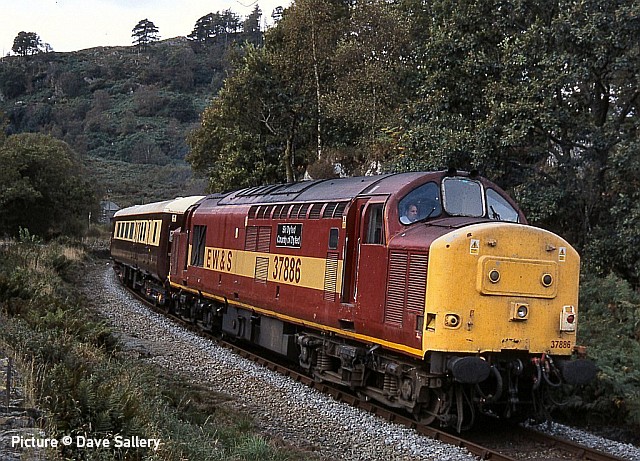
On 8 October 2002 37 886 Sir Dyfed / County of Dyfed near Roman Bridge on the rear of a 'Northern Belle' excursion from Chester to Blaenau Ffestiniog and back, with 47 737 at the other end. Very much a freight loco, with no provision for train heating, but the Northern Belle has its own generator.
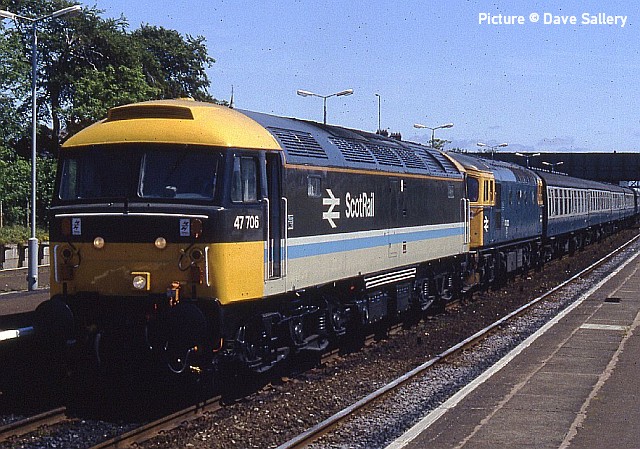
18 July 1986: On a test run after overhaul at Crewe Works, with 33 022 as 'insurance', 47 706 in smart new Scotrail livery passes Prestatyn heading for Holyhead. It was one of 17 Class 47s adapted for 'push-pull' working in Scotland.
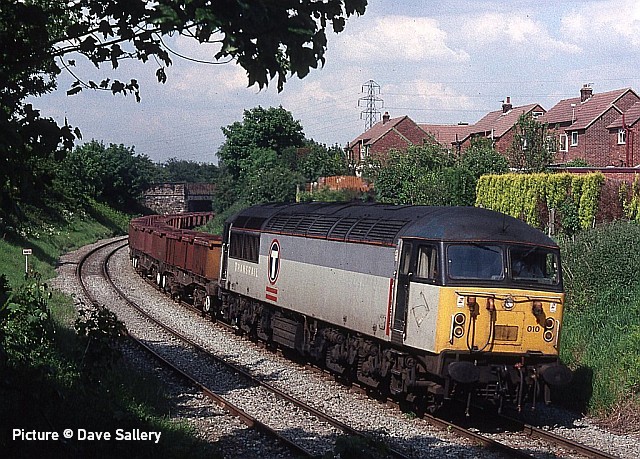
On 3 June 1997, Romania-built 56 010 near Buckey Junction with empty steel coil carriers from Shotton Steelworks. These trains still run, but covered wagons are used to protect the load. The loco, by this time running for the short-lived Transrail company has lost is diamond-shaped cab-side depot plaque. This loco no longer exists, but some of its sisters are part of a current project to create 'Class 69' locos for GB Railfreight using a Class 56 body shell and a EMD engine as used in late-model Class 66 locos.
D200 goes to Holyhead - by 'Skimpler'
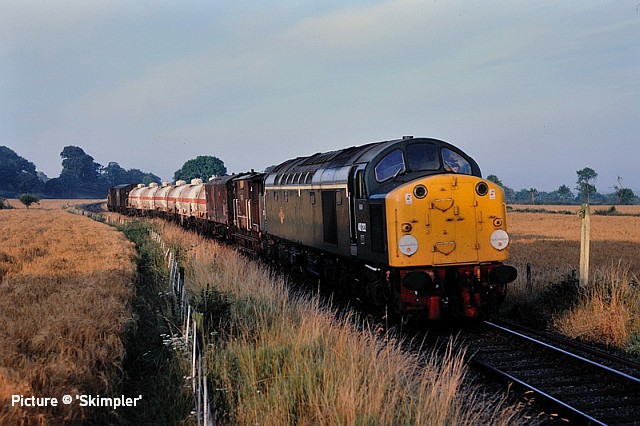
8 August 1984 was a busy day for D200 (40 122)and it turned out to be for me too with an early start. If I managed to drag myself out of bed early enough in the Summer months I'd try and catch the Amlwch goods before work, although as it happened on this day I had a day off. I'd normally go to Bangor station for about 05:45 and see if there was a green on the down main. That meant it was running. At that time of the morning and back in 1984, Aber signalbox would not open until 07:30 so Bangor would normally pull-off when the train left Penmaenmawr, possibly even the Junction but either way, more notice than it would be from Aber. I'd then head for a spot on Anglesey.
This particular morning I went to Holland Arms to wait it out but found that it was already getting a little late in the year for that location as the shadows were longer than I'd like. I had no idea what would be working it and D200 was a nice surprise as was any class 40 by that time. I got my shot (above) and then it was a spin across Anglesey to Rhosgoch.
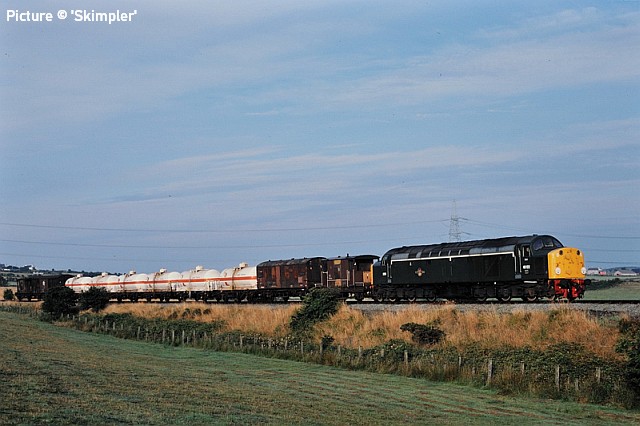
By then there was full sun as it came along the embankment having just emerged from a shallow cutting where the station used to be. This morning the train was fairly short and only had Liquid Chlorine tankers. The train normally also had grey tankers carrying Ethylene Dibromide.
When the train got into Amlwch, they would stop at the exchange sidings by the site of the former station and the crew would normally have a brew. They would wait there until someone from the Associated Octel plant turned up in a van to work the crossings through the town as the line beyond the exchange sidings as the name might suggest, was worked by Associated Octel.

By 1984, a new short bit of road had been built for the A5025 to avoid the "High Street" and it was fitted with an automatic crossing. I think the crossing in town was actually of Salem Street but I had always thought of it as the High Street. The train would not fit between the new crossing and the "High Street" crossing so they would not move off until the Octel man gave them the nod to go through the High street crossing too then they could clear both. I took a low down shot as the eight-axle loco creaked the rails on the curve. It would creep through the town as far as the Lon Goch crossing where it would stop and wait for the man from Octel to close the crossing on the "High Street" behind them and then move around by van to open the next crossing just ahead of them.
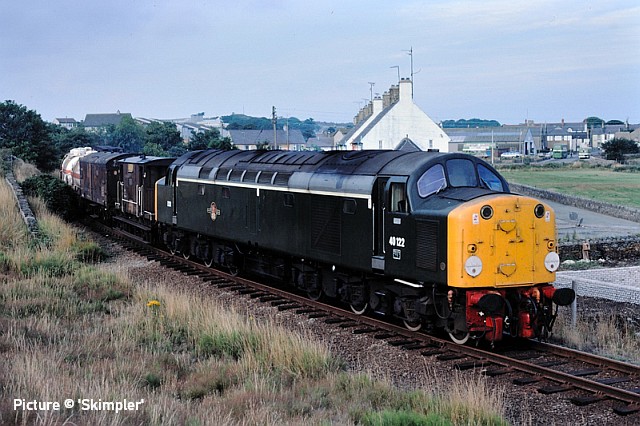
Same process there, and they would move up to the Parys Road crossing. Once through that they were at the plant.
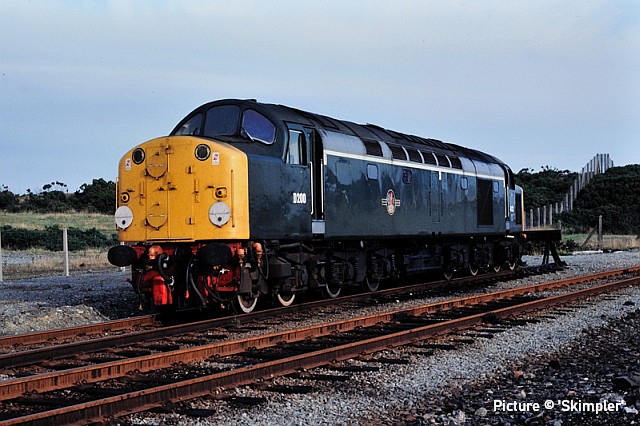
The train would come to a stop just before a point leading onto a short neck, engine would detach and move onto the neck (above) and then the works shunter would come out and collect the train drawing it into the works. The BR engine would then come off the neck and onto the "main" and wait for the works shunter to propel the return train onto it. If it was struggling the BR engine would move back to collect it. The little 0-4-0 diesel would struggle with a heavy train on a wet day and would slip into a side-to-side waddle. The return working would often convey empty Sulphur hoppers too and would be 7D05, Amlwch to Llandudno Junction.
In the afternoon, the Amlwch train would head up to Ellesmere Port and exchange tankers there before returning to Llandudno Junction ready for the next day. On this day, D200 worked an odd little train from Llandudno Junction to Holyhead comprising a coach and a brake van, then, just as oddly really, it worked the nuclear flask train from Valley back to Llandudno Junction but I have no idea what took the flasks to Valley. Busy indeed. It is hard not to think that had these moves taken place in the "more efficient" privatised railway, that day's moves would have required at least three locomotives from different companies, escalating the costs to make road transport a cheaper option. I'm getting cynical as I get older.
[D200 was withdrawn in 1988, and is currently in the National Railway Museum, where volunteers have been engaged in restoration work.]
Heritage Railway Revival - report by Richard Putley
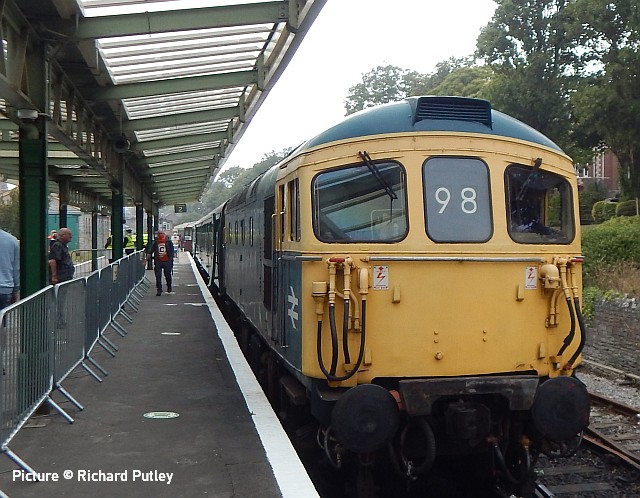
During a recent 'staycation' I visited two heritage railways in Southern England. On the Swanage Railway passenger services were operated by BR Blue 33 111, but they also had another train in use for staff training purposes hauled by Maunsell U class 2-6-0 31806.
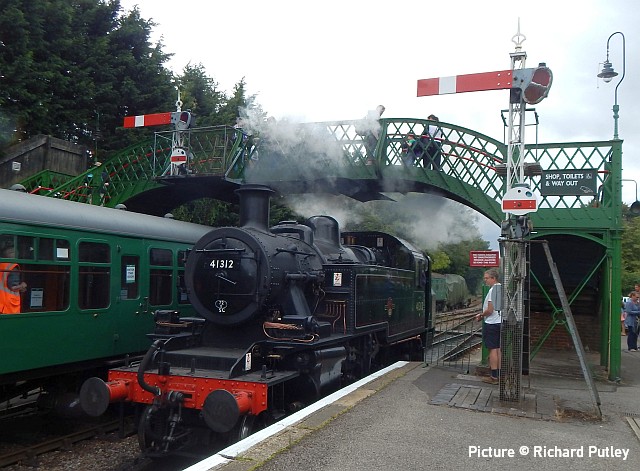
On the Mid-Hants Railway, which I visited last on 19 July, the public service train was hauled by Ivatt Class 2 2-6-2T 41312, a type that was also used in North Wales, seen above at Alresford.
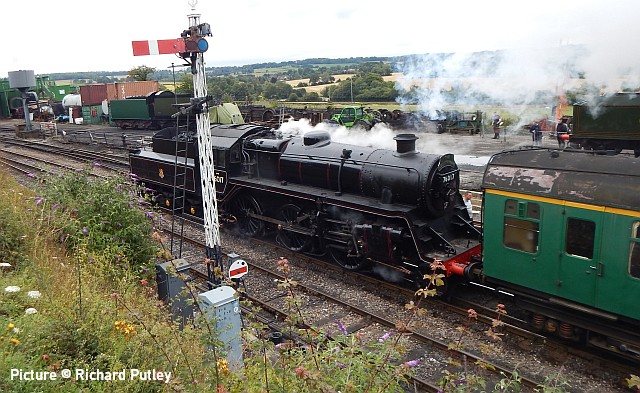
Their "Countryman" dining train, seen at Ropley, was hauled by BR class 4 76017, another type associated with North Wales. ( Between 2005 and 2009 I enjoyed several trips behind sister loco 76079 on the Cambrian Coast Line.)
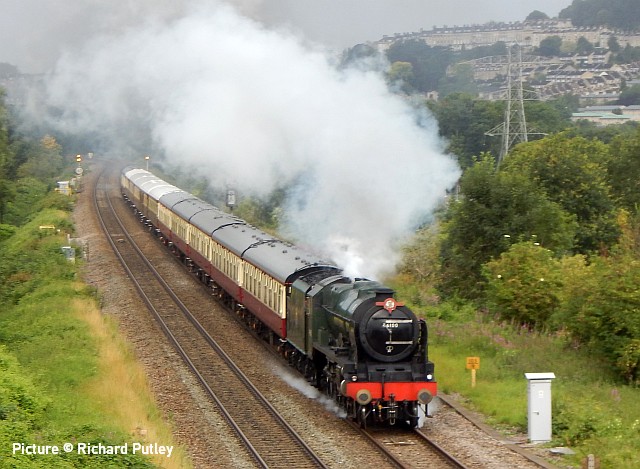
On 26 July I photographed 46100 Royal Scot at Bathampton Junction hauling a Saphos charter from Bristol Temple Meads to Kingswear.
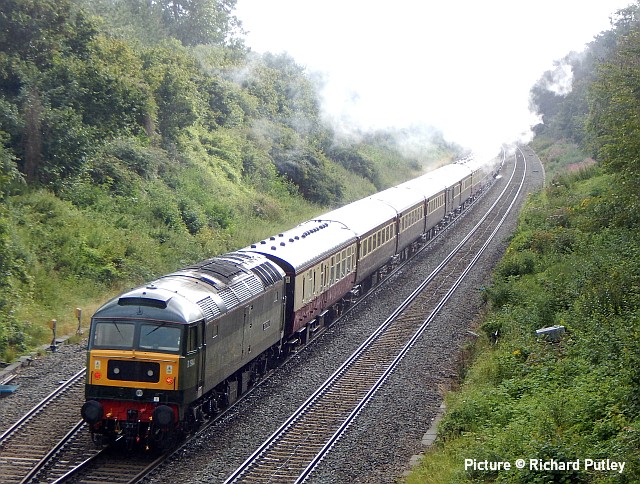
On the back was D1944, while sister loco D1935 was stabled at Bristol Temple Meads.
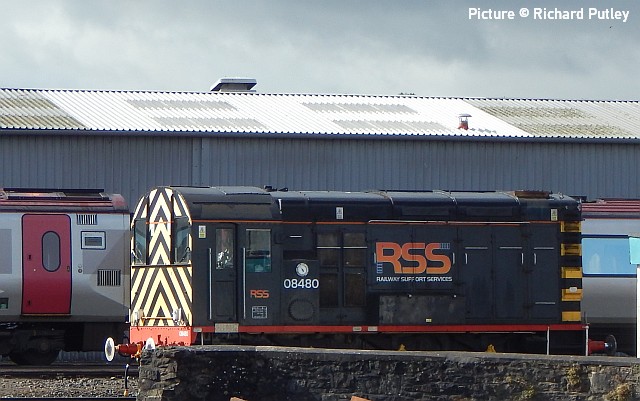
Also at Bristol, resident shunter 08 480 at Barton Hill depot has had a repaint.
North Wales Coast home page | Archive | Previous Notice Board